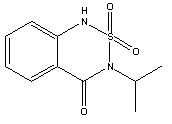Bentazone cas no:25057-89-0
Synonyms: Bentazone,aqueous(25%); 3-Isopropyl-(1H)-benzo-2,1,3-thiadiazin-4-one-2,2-dioxide,aqueous(25%); Basagran; BAS351H; 3-isopropyl-1 H-2,1,3-benzothiadiazin-4(3H)-one 2,2-dioxide(I); 3-isopropyl-1H-benzo-2,1,3-thiadiazin-4one 2,2-dioxide; 3-Isopropyl-1H-2,1,3-benzothiadiazin-4(3H)-one-2,2-dioxide; 3-Isopropyl-3,4-dihydro-2,1,3-benzothiadiazin-4(1H)-one 2,2-dioxide
NameBentazone
CAS25057-89-0
SynonymsBentazone,aqueous(25%); 3-Isopropyl-(1H)-benzo-2,1,3-thiadiazin-4-one-2,2-dioxide,aqueous(25%); Basagran; BAS351H; 3-isopropyl-1 H-2,1,3-benzothiadiazin-4(3H)-one 2,2-dioxide(I); 3-isopropyl-1H-benzo-2,1,3-thiadiazin-4one 2,2-dioxide; 3-Isopropyl-1H-2,1,3-benzothiadiazin-4(3H)-one-2,2-dioxide; 3-Isopropyl-3,4-dihydro-2,1,3-benzothiadiazin-4(1H)-one 2,2-dioxide
EINECS(EC#)246-585-8
Molecular FormulaC10H12N2O3S
Molecular Weight240.28
AppearanceColorless crystals. Odorless.
refractive index1.582
storage tempAPPROX 4°C
Hazard Xn:Harmful
Risk R22;R36;R43;R52/53
Safety
Hazard Codes:? Xn,
Xn, F
F
Risk Statements: 22-36-43-52/53-20/21/22-11
R22:Harmful if swallowed.?
R36:Irritating to eyes.?
R43:May cause sensitization by skin contact.?
R52/53:Harmful to aquatic organisms, may cause long-term adverse effects in the aquatic environment.?
R20/21/22:Harmful by inhalation, in contact with skin and if swallowed.?
R11:Highly flammable.
Safety Statements: 2-24-37-61-36-26-16
S2:Keep out of the reach of children.?
S24:Avoid contact with skin.?
S37:Wear suitable gloves.?
S61:Avoid release to the environment. Refer to special instructions / safety data sheets.?
S36:Wear suitable protective clothing.?
S26: In case of contact with eyes, rinse immediately with plenty of water and seek medical advice.?
S16:Keep away from sources of ignition.
RIDADR: UN 1648 3/PG 2
RTECS: DK9900000
Hazardous Substances Data 25057-89-0(Hazardous Substances Data)
Moderately toxic by ingestion and skin contact. An experimental teratogen. Other experimental reproductive effects. When heated to decomposition it emits very toxic fumes of SOx and NOx.
| Organism |
Test Type |
Route |
Reported Dose (Normalized Dose) |
Effect |
Source |
| cat |
LD50 |
oral |
500mg/kg (500mg/kg) |
? |
Guide to the Chemicals Used in Crop Protection. Vol. 6, Pg. 36, 1973. |
| dog |
LD50 |
oral |
450mg/kg (450mg/kg) |
? |
Pesticide Science. Vol. 3, Pg. 242a, 1972. |
| duck |
LD50 |
oral |
15gm/kg (15000mg/kg) |
? |
Defense des Vegetaux. Vol. 27, Pg. 78, 1973. |
| mouse |
LD50 |
oral |
1130mg/kg (1130mg/kg) |
? |
Yakkyoku. Pharmacy. Vol. 37, Pg. 319, 1986. |
| quail |
LD50 |
oral |
720mg/kg (720mg/kg) |
? |
Guide to the Chemicals Used in Crop Protection. Vol. 6, Pg. 36, 1973. |
| rabbit |
LD50 |
oral |
750mg/kg (750mg/kg) |
? |
"Wirksubstanzen der Pflanzenschutz und Schadlingsbekampfungsmittel," Perkow, W., Berlin, Verlag Paul Parey, 1971-1976Vol. -, Pg. -, 1971/1976. |
| rat |
LC50 |
inhalation |
5100mg/m3/4H (5100mg/m3) |
? |
Pesticide Manual. Vol. 9, Pg. 65, 1991. |
| rat |
LD50 |
oral |
1100mg/kg (1100mg/kg) |
? |
Guide to the Chemicals Used in Crop Protection. Vol. 6, Pg. 36, 1973. |
| rat |
LD50 |
parenteral |
1100mg/kg (1100mg/kg) |
? |
Defense des Vegetaux. Vol. 26, Pg. 5, 1972. |
| rat |
LD50 |
skin |
2500mg/kg (2500mg/kg) |
? |
"Wirksubstanzen der Pflanzenschutz und Schadlingsbekampfungsmittel," Perkow, W., Berlin, Verlag Paul Parey, 1971-1976Vol. -, Pg. -, 1971/1976. |


 Xn,
Xn, F
F